I just discovered the awesome photography of Léon Gimpel, a turn-of-the-last-century Parisian amateur-turned-pioneering-photojournalist. He was one of the first photographers in France to experiment with shooting color; he engineered his own chemical tweaks to the Lumiere brothers' Autochrome technology as early as 1907, and he shot color photographs of World War I. World War I, people!
Here's a combat series he shot over a couple of weeks in August-September 1915, when he was embedded with L'Armée de la rue Grenéta. Petit Chap presented a much larger selection ordered for aesthetic/narrative effect, but in the interests of journalistic integrity, here they are in [their purported] chronological order:
22 août 1915 - L'Armée de la rue Grenéta : remise d'une décoration sur le front des troupes

29 août 1915 - La Guerre chez les gosses: exécution d'un Boche... au moyen d'une pièce de 75!
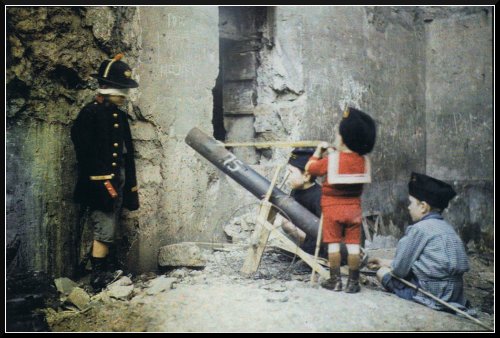
12 septembre 1915 - Interrogatoire d'un prisonnier
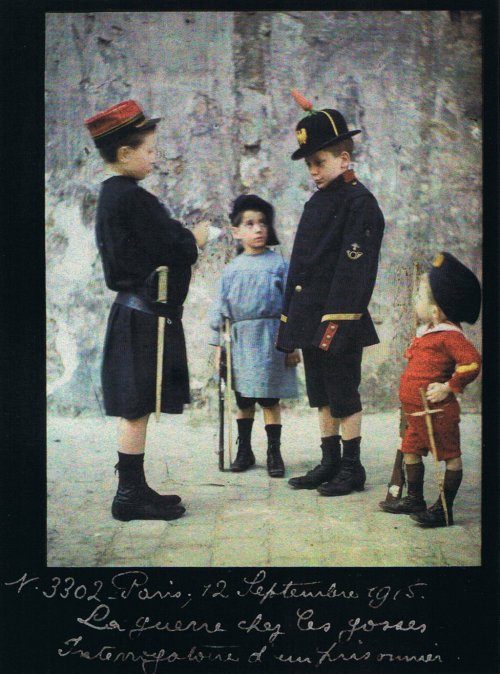
19 septembre 1915 - Un « Taube » est signalé; une pièce de 75 est aussitôt mise en batterie pendant que l'aviateur « Pépète » s'apprête à le prendre en chasse

19 septembre 1915 - l'aviateur « Pépète » vient d'abattre un « Taube » à coups de mitrailleuse

19 septembre 1915 - le célèbre aviateur « Pépète » triomphe devant sa victime
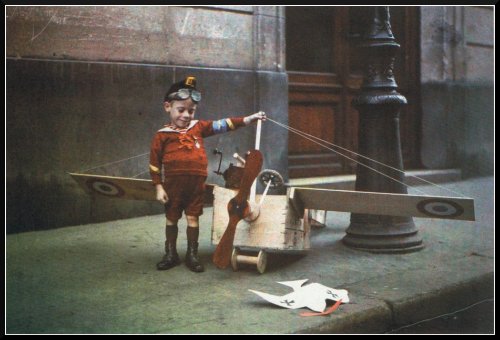
Yeah, yeah, if not by the time the executed Boche reappears a week later in perfectly composed surrender and interrogation shots, then by the time you see « Pépète » dangling unaided from a lamppost, you realize the entire thing is being staged for Gimpel's camera. Which doesn't make it any less real; I mean, what were urchins in Paris doing in the smack middle of World War One, right? Still, you gotta feel bad for the kid who always got stuck playing the Boche.
UPDATE: Some interesting comments below about the dates of these photos. It's not definitive, but the Australian War Memorial site apparently included them in an exhibition of rare color photos of WWI. Gimpel befriended the kids who lived on this street in a largely commercial neighborhood, and who had formed their own army, which Gimpel would come and document--and provide logistical and supply line support for--on Sundays. Fascinating.
Léon Gimpel, reporter [petitchap.com]
Léon Gimpel (1873-1948), the audacious work of a photographer, 2008 [musee-dorsay.fr]

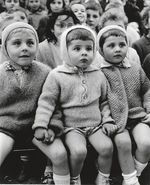

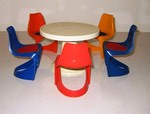
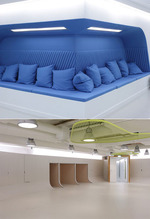
How sure are you on those dates? Because in all my early car research, I've never seen a roll-up overhead garage door outside a railyard before the Twenties. And wouldn't they have been biplanes? Were there any sort of planes in 1915 that resembled that paper silhouette? Weren't the Germans bombing Paris in 1915--wouldn't all the glass have been blacked
out?
Those kids are clean and well-fed, and how does he have time to stage this during a war? I call bogus. It just doesn't "feel" right to me. Is there a costume expert out there to tell us if the clothing fits the era?
Well, this is labelled a French WW I monoplane, very similar layout to the photo, and the suggested manufacturer, Morane-Saulnier, had many WW I era monoplanes with a similar style; the A, G, H, anf N are all prior to or concurrent with WW I, for example.
interesting point about the shutter door. rue Greneta is one of the few streets in Paris not on Google Street View, so I couldn't go in and ID the exact location of these photos. Not that it'd help date them, of course.
If they're legit, I assume they were running in L'Illustration at the time, so there should be a contemporary record. And if that one has a negative number attached to it, perhaps they slot into his archive somehow, too. I'm waiting for my Gimpel catalogue to arrive from It'ly, so maybe there's more info there.
Well, I added the link above from the Australian War Memorial, which discusses Gimpel's work in an exhibit of rare color WWI photography. It all sounds true.
Given that Grenata is about five feet wide and some appears to have been pedestrianized, little wonder it's not on Street View.
In 1909 it appears to be unpaved (it is cobbled in Gimpel's photos).
http://www.wetcanvas.com/Museum/Artists/c/Jules_Cheret/RueStDenis/StDenis_greneta.jpg
Here it is today http://thesewingdivas.files.wordpress.com/2010/08/rue-greneta-looking-towards-montorgueil.jpg
Some more photos would be helpful; this second shows a rue far too narrow for the Gimpel pics, which of course doesn't mean the sidewalk scenes couldn't have been taken elsewhere on the street. If we had a higher resolution version of http://lh5.ggpht.com/_L_bRD9cLUxU/S55ZmoIk6GI/AAAAAAAADaI/d6RtazsrnJw/guerre-des-enfants_5.jpg, we could make out the street number, 500-something (571?), (and also take a look at the bulb in the lamppost).
Please, I have nothing against Pere Gimpel, it's just that something about this arouses my suspicion. It's too perfect.
OK, two more niggling comments, then I'll leave it alone: I have yet to find a photo which shows Grenata with streetlights at all; again, that doesn't mean anything--he could have taken the street shots anywhere; they could have been scrapped in WWII, who knows.
Second, was the 11e arrondisment bombed in WWI? What are those ruins they're in?
1915 issues of l'Illustration go for about six bucks on eBay...
These are great, as are the ones you posted on the other side. There's just something surreal about early color photography.
Regarding the roll up door- that looks more like a security shutter covering up a shop entrance to me. Which would make sense on a Sunday, which is what 19/9/15 was.
One of those pictures was published in the book The First World War by Hew Strachan, along with several other rare colored photographs from WWI.